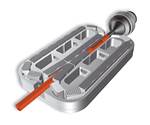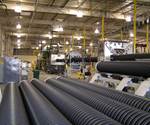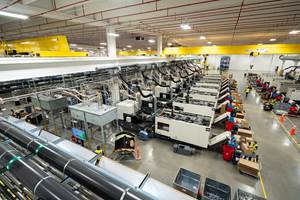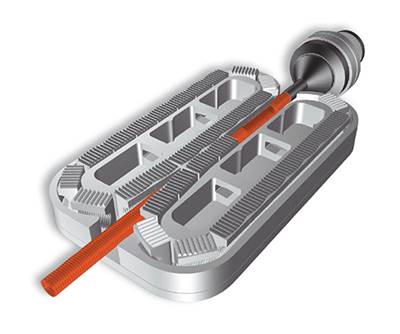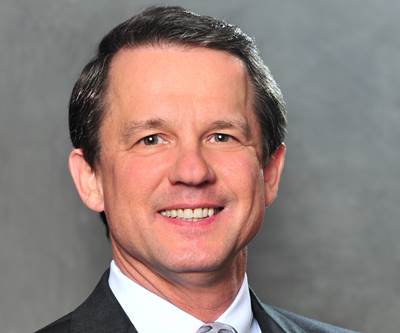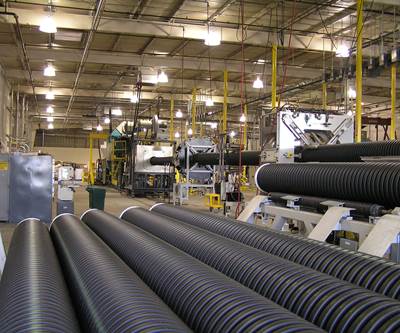Humble beginnings … If you asked processors today to trace their roots, many would use those words. Advanced Drainage Systems (ADS) is no different. It was launched in Wilmington, Del., in 1966 by Ron Martin and Marty Sixt, two engineers who grew up on farms and knew a thing or two about maximizing crop yield through better water management. Together, they modified old extruders—“putting pieces and parts together,” in the words of Brian King, ADS’ executive v.p. of product management and marketing—and sowed the seeds of the still-burgeoning plastics pipe market by starting a company focused on HDPE corrugated pipe as an option for clay tile in farm water distribution.
In the years that followed, ADS added talent, technology, and facilities. It moved to Ohio in the early 1970s and began to add plants around the county that were situated within a 300-mile radius of hot markets for construction. ADS also started educating civil engineers, commercial and residential contractors, and anyone else involved in construction and infrastructure on the benefits of plastics over more-established steel and concrete for water management..
Today, as a result of organic growth driven by product development, acquisitions of competitors such as Hancor, and a keen focus on becoming truly sustainable, ADS is one of the largest drainage pipe producers in the world. Headquartered in Hilliard, Ohio, it’s now a publicly held company with 65 plants in North America (and three in South America through a joint venture), more than 5000 employees, extrusion capacity of approximately 1 billion lb/yr, and decades of double-digit growth that have brought its annual sales to $1.9 billion. It estimates that it has more than 10 billion ft of pipe in service worldwide.

ADS N12 corrugated HDPE pipe is used for stormwater management and agricultural tiling systems.
The company has an undisclosed number of extrusion lines around the country, designs dies in-house that are built by its tooling suppliers, and has injection molding capacity to fabricate pipe fittings. It has complemented its line of corrugated pipe products—which include what’s believed to be the first-ever corrugated PP pipe—with what ADS calls allied products—retention/detention chambers made of extruded PP, basins, septic systems, specialty pipe products, water-quality units and a variety of connections and fittings. ADS also operates its own fleet of trucks that strengthens its service platform for its customers.
“Over the years we have had different investors and changes in leadership, including being an ESOP (Employee Stock Option Plan)company,” remarks King. “Our growth has mainly been organic, resulting from developing new products and adding new plants. One of the game-changing products came in 1987, when we introduced the N-12 corrugated dual-wall HDPE pipe with a smooth inside wall to improve water flow. We extrude a green stripe on our corrugated pipes, and that has become an iconic symbol and a representation of our brand that lets the customer know they are working with an ADS pipe. We also made acquisitions, the biggest of which was Hancor in 2005, which had 15 plants operating in North America.”
ADS went public in July 2014, a move that King believes put ADS on a fast track for growth and in a better position to attract top-level talent. “Being a publicly traded company has given us the ability to easily access capital,” he remarks. He specifically refers to ADS’ 2019 acquisition of Infiltrator Water Technologies as something that likely “would not have been possible had we not gone public.” Infiltrator makes PP-based leach-field chambers and systems, septic tanks and accessories, primarily for use in residential applications. Prior to the acquisition, Infiltrator was a 15-yr customer and supplier of ADS.
ADS sells its products through a network of distributors and at major home-improvement centers. In some cases, that might be viewed as somewhat risky since it puts a third party between the company and end users. That could be concerning in the markets ADS serves, where, King notes, “Plastic is still the new kid on the block,” compared with some other materials like concrete and corrugated metal pipe. “But our distributors are our partners and don’t stand in the way of us developing and maintaining the relationships we have with the final customer. We typically share new product designs and prototypes with them because their input is invaluable.”
He continues, “Our salespeople and distribution partners work together, which is critical for JIT and the ability for the customer to get the proper products from one place. And we have people—in sales, engineering, product development, and other areas—who talk to our distribution partners, engineers, contractors and municipal officials every day.”
Those relationships figure to benefit ADS nowadays, as residential and commercial construction are both booming. Says King, “The key drivers that we track for our business—the commercial construction business, infrastructure, residential—are all positive. For a while during the pandemic, we were concerned a bit about the commercial sector. But that’s rebounded as we’ve seen warehouses and large manufacturing-plant projects get started as companies move to get serious about tightening up the supply chain and reshoring.”

ADS extrudes corrugated pipe in a wide range of diameters and lengths.
Opportunities also beckon for ADS with a national infrastructure bill looming. Comments King, “Plastic pipe is a sustainable product. It installs faster, and from a value proposition it’s better than competing materials. The term ‘resilient infrastructure’ has come up many times in discussions about what’s in the bill. We have to build back in a resilient way, and we believe plastic pipe is the most resilient solution.”
Making Recycling Work
ADS considers its ability to “make money using post-consumer recycled material” as a strong differentiator between it and its competitors. Since 2007, ADS has been issued more than 30 patents in the area of recycling and literally set the standard for how post-consumer HDPE can be deployed in corrugated pipe, working with industry groups to develop guidelines. The Infiltrator purchase pushed the amount of recycled material ADS will use to roughly 550 million lb/yr. .
ADS started recycling by buying scrap from third parties, including other processors. Now, ADS Recycling operates nine recycling plants across the country, handling both post-consumer and post-industrial scrap. “But getting recycled material continues to be a challenge,” says King. “If we could get more to include in our manufacturing process we would. In fact, we’d like to double the amount of recycled material we include in our products, without backing down on the amount of virgin material we run.”
“We’d like to double the amount of PCR we include in our products, without backing down on the amount of virgin material we run.”
In particular, ADS is looking for more sources of post-consumer PP and has joined The Recycling Partnership to assist in that effort. The Recycling Partnership is a national non-profit organization that works with communities and companies to improve recycling systems. Its funding partners include a wide array of materials companies, processors, brand owners and retailers.

ADS recycles more than 500 million lb a year, and would like to double that amount.
Manufacturing Strategies
All told, ADS has 20 different product categories and thousands of SKUs, considering that its products can be ordered in various lengths and diameters. This can complicate matters even for a manufacturing operation the size and scope of this company. “Where and when we can, we like to turn machines on and run them for as long as we can,” King says. “But we don’t always get to do that. Demand changes. The challenge for our operations team is how do you support manufacturing as demand changes? How do you most profitably and economically get our customers the products they need, when they need them?”
“Today, as demand is quite high, every piece of product that comes off the line is most likely sold and going to somebody right away.”
Typical runs at ADS can last days. Manufacturing is set up using product wheels, and at ADS that means jobs are scheduled smaller to larger (in diameters) and longer to shorter (in lengths) to minimize changeovers. Some plants run 24:7. Most of the pipe ADS extrudes is monolayer from multiple material blends. King says ADS does some coextrusion, but more multilayer structures may be on the horizon.
He explains, “We are always looking to make a better product, a more complete package and system. We look at market segments where we are underpenetrated compared with metal and concrete. In certain applications there is structural load. So how do you use plastic in these applications? That is where coextrusion may come in.”

Operator affixes gasked to corrugated HDPE pipe with iconic green line.
Whether one layer or more, ADS has not been inventorying product lately. “Today, as demand is quite high, every piece of product that comes off the line is most likely sold and going to somebody right away,” King notes. “If we are making it, we are selling it. In normal times, we keep a certain level of inventory and ship from that. Distributors assist by stocking certain products.”
ADS has been adding material-science and engineering experts to the team to help turn ideas gleaned from regular field research into products. “We work on solving the right problems, and the best way to do that is go out and talk to distributors and customers and watch what they are doing and experience the challenges they are facing, and use that information to develop products that solve those challenges,” says King. He notes that the company has recently made big capital investments in both new extruders and injection presses in anticipation of growing demand.
“Our reason is water,” King says. “We capture it in some form of basin, we convey it through pipes, we then store it in some of our retention/detention systems, and then we treat it before returning it to the environment. This shapes how we think about products and applications, how we manage our product categories, even how we market. Ultimately that will allow us to make better products and to communicate to people about what we do and how we do it. We are stewards of environment and water.”
Related Content
Wacker To Introduce Powersil 1900 A/B High-Consistency Silicone Rubber
Product was developed for application in hollow-core insulators.
Read MoreFarrel Pomini Compact System Billed as Ideal for WPC Processing
Machine can be used to cost-effectively extrude composite decking by bypassing pellet milling.
Read MoreIPEX Opens Injection Molding Facility in North Carolina
The pipe and fittings manufacturer’s new 200,000-square-foot facility represents a $200 million investment and will create 150 jobs.
Read MoreInfrastructure May Prove Big Landing Spot for Recycled Plastics
As the government funds infrastructure improvements, a hot topic at NPE2024 – exploration of the role recycled plastics can play in upcoming projects, particularly road development.
Read MoreRead Next
Evaluating a Corrugator For Small Tube Applications
Here's a review some of the key variables in the technology and how they impact the process.
Read MorePlastics Pipe Institute Talks Recycled Plastics Use
Tony Radoszewski, Plastics Pipe Institute president, discusses recycled content in pipe and converting packages with a 60-day shelf life into products with a 100-year service life.
Read MoreBlazing the Trail In Processing PCR for Corrugated Pipe
Just a decade ago, roughly 10% of HDPE corrugated pipes made by Advanced Drainage Systems used recycled material. That number is 65% now, and growing. Here’s how this processor became a pioneer in this field.
Read More


